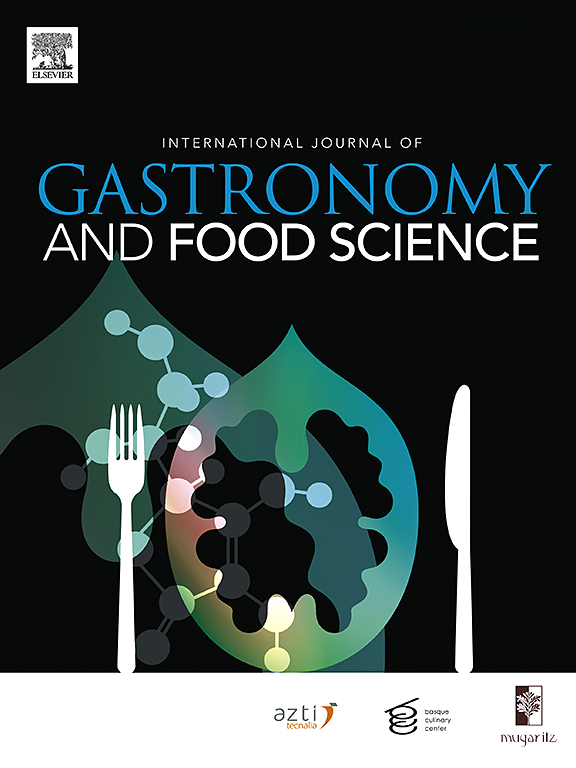调和口味:令人兴奋的音乐和声音如何影响食物的感知和情绪反应
IF 3.2
2区 农林科学
Q2 FOOD SCIENCE & TECHNOLOGY
International Journal of Gastronomy and Food Science
Pub Date : 2024-12-21
DOI:10.1016/j.ijgfs.2024.101093
引用次数: 0
摘要
本研究旨在通过主观和客观(即电生理)方法,对音乐和声音的觉醒变化如何影响食物感知和相应情绪反应的时间变化提供一种新的理解。兴奋状态与低效价和高唤醒有关,而平静状态与高效价和低唤醒有关。平静的音乐(CM)、平静的声音(CS)以及平静的音乐和声音的组合(CMCS)唤起了喜悦、放松、平静、愉悦和轻松等情绪,并与甜味和奶油味的感知相关。相反,令人兴奋的音乐(EM)提高了唤醒,唤起了诸如活动、热情、能量和兴奋等情绪,并放大了对烘焙和苦味的感知。令人兴奋的声音(ES)以及令人兴奋的音乐和令人兴奋的声音(EMES)相结合的情况与焦虑、疲劳、不安、不快乐、注意力难以集中、烦躁和不安呈正相关,并增强了对烘焙和苦味的感知。此外,EM和EMES条件显著提高了皮肤电导和呼吸速率,与烘焙和苦味的感知有相应的相关性。ES和EMES条件下心率和呼吸速率明显升高。CM组心率和情绪反应明显增高,而CS组皮肤电导明显增高。本研究结果表明,在不同的音乐和声音条件下,感官属性与食用冰淇淋时所引起的情绪和生理反应密切相关。本文章由计算机程序翻译,如有差异,请以英文原文为准。
Harmonising flavours: How arousing music and sound influence food perception and emotional responses
This study aims to provide a novel understanding of how music and sound varying in arousal can affect temporal changes in food perception and the corresponding emotional responses, measured through both subjective and objective (i.e., electrophysiological) methods. Exciting conditions are associated with low valence and high arousal, whereas calm conditions are associated with high valence and low arousal. Calm music (CM), calm sound (CS), and a combination of calm music and sound (CMCS) evoked emotions such as joy, relaxation, calmness, pleasantness, and at ease, and were correlated with the perception of sweetness and creaminess. Conversely, exciting music (EM) increased arousal, evoked emotions such as, activity, enthusiasm, energy, and excitement, and amplified the perception of roasted and bitter flavours. Exciting sounds (ES) and combined exciting music and exciting sound (EMES) conditions were positively correlated with anxiety, fatigue, unease, unhappiness, difficulty concentrating, irritation, and restlessness, as well as enhancing the perception of roasted and bitter flavours. Furthermore, the EM and EMES conditions gave rise to significantly higher skin conductance and respiration rate, with corresponding correlations with the perception of roasted and bitter flavours. The ES and EMES conditions demonstrated significantly higher heart rate and respiration rate. The CM condition showed significantly higher heart rate and emotional responses while the CS condition showed significantly higher skin conductance. The findings of this study indicate that sensory attributes are closely associated with the emotions and physiological responses evoked when consuming ice cream under different music and sound conditions.
求助全文
通过发布文献求助,成功后即可免费获取论文全文。
去求助
来源期刊

International Journal of Gastronomy and Food Science
Social Sciences-Cultural Studies
CiteScore
5.30
自引率
10.50%
发文量
170
审稿时长
45 days
期刊介绍:
International Journal of Gastronomy and Food Science is a peer-reviewed journal that explicitly focuses on the interface of food science and gastronomy. Articles focusing only on food science will not be considered. This journal equally encourages both scientists and chefs to publish original scientific papers, review articles and original culinary works. We seek articles with clear evidence of this interaction. From a scientific perspective, this publication aims to become the home for research from the whole community of food science and gastronomy.
IJGFS explores all aspects related to the growing field of the interaction of gastronomy and food science, in areas such as food chemistry, food technology and culinary techniques, food microbiology, genetics, sensory science, neuroscience, psychology, culinary concepts, culinary trends, and gastronomic experience (all the elements that contribute to the appreciation and enjoyment of the meal. Also relevant is research on science-based educational programs in gastronomy, anthropology, gastronomic history and food sociology. All these areas of knowledge are crucial to gastronomy, as they contribute to a better understanding of this broad term and its practical implications for science and society.
 求助内容:
求助内容: 应助结果提醒方式:
应助结果提醒方式:


